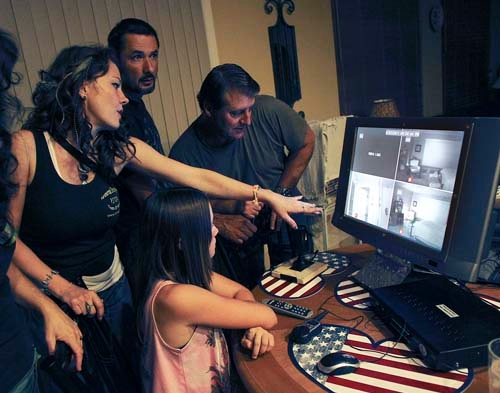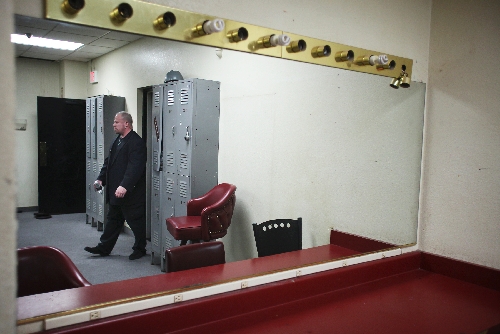Teams stay busy investigating paranormal calls




"You’re just disgusting," yells the man pacing back and forth between the darkened bedroom and bathroom. "I hate you, you coward."
He’s not speaking to anyone in the room, but to everything, the walls.
"Show yourself."
The man, a 20-year-old named Michael, has seen "it" countless times over the past five years. A 6-foot-tall "shadow man," he and his family call the intruder.
The figure walks down the stairs and stands there, staring down a hallway at Michael sitting in the living room.
"It’s not out of the corner of my eye anymore," said Michael earlier that night. "He sees me and stands there for three to four seconds, then goes back upstairs."
His mom has seen it in her bedroom more than anywhere else. But she doesn’t want the word getting out that she sees ghosts. That’s a stigma she doesn’t want wrapped around her family.
She allowed a reporter in her house, but only on the condition that the family’s last name not be used. It’s a condition requested by all the folks who have been haunted in this story and for the same reason.
Michael continues to provoke the shadow man, calling him a wuss and worse.
On this night, they aren’t alone.
Four full-spectrum cameras — seeing through the dark of night — catch his every move. Their cords snake across the carpet, down the stairs, along a hallway, and into the kitchen, feeding into a flat-screen monitor on the table. There, paranormal investigator Kelly Elkins sits, watching the live footage with a couple other members of his team.
"Does this stuff work? We don’t know," he says, referring to all the ghosthunters’ tools, such as electromagnetic-force detectors called K-II meters.
Approximately two dozen paranormal investigation teams are operating across the valley. And most of the ghosthunters have normal careers — nurses, police officers, aircraft mechanics, truck drivers, chefs and more. They keep their day jobs because they must. And they don’t charge a dime to investigate. If they did, clients would become suspicious. It’s more of a passion, a hobby.
These teams consistently receive calls from local home and business owners who have claimed to exhaust all normal explanations. They now look to the paranormal.
"I never believed in all this crap. I really didn’t until I moved into this house," said Michael’s mom, Gail, who lives with her husband and five children in a well-kept home that looks no different than any other in the Henderson neighborhood. "We’ve all seen something."
She just wants answers.
"What does it want? Why is it here?" she said.
But Elkins’ team can’t provide any answers, only theories.
A sudden increase in electromagnetic levels is supposed to suggest a spirit trying to communicate. Investigators tell spirits to make the meter peak twice to answer yes and once for no. A device also throws a grid of green laser dots onto the walls. The idea is that any disruption of the dots would suggest something is there.
"We’re looking for something, consistent feedback, a pattern," says Elkins, a thick-figured man with long hair and a chest tattoo poking through the collar of his shirt. "We’re still in the infancy of our understanding. This is a pseudoscience."
THE PARANORMAL FOOD CHAIN
But amateur investigators aren’t doing anything close to science, asserted professor Gary Schwartz of the University of Arizona in Tucson. Schwartz is one of the few "parapsychologists" working at an U.S. public university. The fringe sub-discipline of psychology attempts to scientifically prove the paranormal through controlled experiments.
Schwartz knows of only one other public school, the University of Virginia, with a lab doing similar research.
But even Schwartz, a former Yale University psychology professor with a doctorate from Harvard University, isn’t accepted by his peers. Mainstream scientists look down on Schwartz in the same way that Schwartz disregards weekend hunters, claiming their experiments are flawed and the results willed.
Despite being the smallest fish in the food chain, weekend investigators aren’t dissuaded from taking their work seriously.
Wallie Luna, founder of Las Vegas Paranormal Authority, said the best teams aren’t quick to buy into ghost stories. They start out assuming the explanation is natural.
"We are very skeptical, yet we are believers," said Luna, whose team conducts an intensive interview on every potential client.
Sometimes, people mix medications. Others watch too many ghost-adventure shows, he said. The simplest explanation is often the truth. Even in the rare case when a call seems promising and an investigation ensues, Luna’s team finds supporting evidence only 20 percent of the time.
"It’s rare, very rare," he said, and the evidence is never a ghost caught on tape but the so-called crumbs left behind.
THERE’S NEVER PROOF
A tape recorder on Gail’s bedroom carpet catches Michael’s insults but, more importantly, the white noise.
Elkins’ Paranormal Investigation Team of Nevada relies on subtle indications of "consciousness after death." Audio recorders catch low, barely perceivable noises called EVPs or electronic voice phenomena. Since ghosts can’t talk, investigators claim they communicate using energy. That’s the theory. The volume is cranked high to hear the quick bursts of sound, never long sentences, usually just a few syllables.
Analyzed audio recordings from the night caught a quick sound between Michael’s tauntings. It sounds like "punk." Two other clips sound more like whispering voices, saying "We’re moving out" and "This (expletive) is wrong."
A few seconds of sound from hours of recording. Another supposed voice was indistinguishable.
But even Elkins, an investigator himself, is skeptical.
"We have these ‘discoveries,’ " Elkins said. "I don’t say evidence and certainly not proof."
But clients often don’t like to hear that.
"The worst thing a client can hear is …" Elkins said, pausing, "… ‘Nothing’s here.’ "
It’s a surprising reaction that investigator Brian Purdy has also noticed.
"They want to be told it’s paranormal. That’s why we’re there," said the founder of Elite Vegas Paranormal Society. "There’s never proof. That being said, I have stuff on film and tape that there’s no explanation for."
On the other hand, some clients utterly deny the notion of ghosts, said the stepmother-and-daughter team from Sin City Spirit Seekers.
"They just want someone else to see it too, to say they’re not crazy," said stepmother Jill Willis, "but they don’t want anyone to know."
They fear for their reputations, added daughter Kim.
"And they’re afraid it’s going to escalate," Purdy said. "Somehow, their dream home, their sanctuary, is going to become a nightmare."
That was the case for Las Vegas resident Hugh. His 18-year-old son, a straight-A student entering the Air Force, was being bullied but wouldn’t tell Hugh for almost a month.
"He was horribly embarrassed," Hugh said. "He was waking up at 2 in the morning to footsteps in the room and breathing on his neck."
His son originally thought it might just be a convincing dream, but it kept happening. And then his bed began shaking when he was wide awake. He got up and turned on the lights.
That’s when Hugh called the four-man team of Ghost Town Operations. They came over and claimed they used the electromagnetic-force meter to communicate with the spirit, asking him questions. They told him to spike the meter twice for yes and once for no.
"We found out that he didn’t like the boys or Hugh at all," team member John Cushman said.
After a night in the house, Cushman told Hugh that the spirit was the father of his fiancée, which surprised Hugh. He never told the team about her father, who died before the couple had met and was described as protective. Hugh and his sons had recently moved into the fiancée’s house.
"I tried to explain to him (the ghost) that Hugh loves his daughter," Cushman said.
Hugh hasn’t had any problems since then. Clients aren’t the only ones with vulnerable reputations.
"My friend looked straight in my eyes and said, ‘You believe in that,’ " investigator Luna said. "I thought you were smarter than that. That hit me in the heart."
Nevertheless, investigators believe they’re serving a purpose beyond simply satisfying their appetites for the abnormal.
Does the conscious mind survive the body’s death? That’s the ultimate question.
Elkins and his team has set it sights on approaching the answer. His vision is to compile their years of data with other investigators and look for patterns. But the field isn’t by any means organized, and doesn’t require credentials.
Even if it were, weekend investigators are incapable of providing the evidence, asserted Schwartz, the University of Arizona parapsychologist.
"What they’re doing is, at best, anecdotal," Schwartz said, because their experiments aren’t controlled. "It’s more for drama than it is for data."
ON THE BLEEDING EDGE
Schwartz first became interested in the paranormal because of light.
"Even after a star dies, the light can be seen billions of years later traveling here," he said. "Is our energy and information like the light from distant stars?"
That’s when he decided to leave the fold of his scientific peers and risk his reputation, while still applying the scientific method.
"Sometimes, you need to go into the dark to see the light," he said, speaking metaphorically and literally.
But how would we continue on? And how could that be detected? Schwartz thinks light may be the answer. He recently completed an experiment using a pitch-black room. No light whatsoever.
A device that reads tiny traces of light was set up inside the room. When spirits were invited in, it captured "structures of light."
This is just the latest of many experiments that Schwartz claim provide evidence of the afterlife. No room for error is acceptable in this research.
"You always have to look over your shoulder because there’s so much scrutiny," he said. "Colleagues have a lot of questions about this because it flies in the face of their educations. Extraordinary claims require extraordinary evidence."
But few scientists will listen. Schwartz claims that’s because they put personal opinion first.
STRUGGLING AGAINST STATUS-QUO SCIENCE
Ray Hyman, emeritus psychology professor at the University of Oregon, is parapsychology’s most noted critic. He doesn’t believe in ghosts, but said that’s not the issue.
"This flies in the face of reality," he said, claiming Schwartz’ findings are flawed. "There’s no evidence for it. The brain creates these experiences, these ghosts."
Hyman’s interest in psychology began when he was a young magician, realizing the supernatural isn’t real but mere self-deception, "seeing what you want to see."
Schwartz is seeing what he wants to see, Hyman said. But even doubting scientists realize they aren’t all-knowing.
"If they are able to prove it, they’ll be the Isaac Newtons of the new world," Hyman said.
That incentive keeps these fringe scientists going.
"We used to think the Earth was flat. We were wrong," Schwartz said. "We used to think the sun revolved around the Earth. But it’s the other way around. We used to think objects were solid. Now, we know they’re mostly empty space. Our perception is very limited."
And so, Elkins sits in front of his monitor, watching a split screen of four live video feeds. He remains there into the darkest hours of morning, looking for something. But he doesn’t know what. Something not normal.
He’s surrounded by stories.
Just a few feet from Elkins’ chair, Gail was watching TV not too long ago when she heard an unmistakable sound: A dog trying to run on her wood floor, its nails scraping and sliding. She then felt something bite her lip. She’s seen the dog many times. It’s not transparent but seemingly of substance, black furred.
Even Elkins doesn’t know whether he believes in ghosts.
By the end of the night, he still hadn’t seen one.
Contact reporter Trevon Milliard at tmilliard@reviewjournal.com or 702-383-0279.
AC_FL_RunContent( ‘type’,’application/x-shockwave-flash’,’data’,’https://www.reviewjournal.com/media/audio/mp3small’,’FlashVars’,’MFILE=https://www.reviewjournal.com/media/audio/ghost_this_shits_wrong.mp3&MSTART=no’,’width’,’135′,’height’,’30’,’movie’,’https://www.reviewjournal.com/media/audio/mp3small’,’classid’,’clsid: D27CDB6E-AE6D-11cf-96B8-444553540000′,’codebase’,’http://download.macromedia.com/pub/shockwave/cabs/flash/swflash.cab#version=8,0,0,0′ ); //end AC codeAC_FL_RunContent( ‘type’,’application/x-shockwave-flash’,’data’,’https://www.reviewjournal.com/media/audio/mp3small’,’FlashVars’,’MFILE=https://www.reviewjournal.com/media/audio/ghost_moving_out.mp3&MSTART=no’,’width’,’135′,’height’,’30’,’movie’,’https://www.reviewjournal.com/media/audio/mp3small’,’classid’,’clsid: D27CDB6E-AE6D-11cf-96B8-444553540000′,’codebase’,’http://download.macromedia.com/pub/shockwave/cabs/flash/swflash.cab#version=8,0,0,0′ ); //end AC code
AC_FL_RunContent( ‘type’,’application/x-shockwave-flash’,’data’,’https://www.reviewjournal.com/media/audio/mp3small’,’FlashVars’,’MFILE=https://www.reviewjournal.com/media/audio/ghost_punk.mp3&MSTART=no’,’width’,’135′,’height’,’30’,’movie’,’https://www.reviewjournal.com/media/audio/mp3small’,’classid’,’clsid: D27CDB6E-AE6D-11cf-96B8-444553540000′,’codebase’,’http://download.macromedia.com/pub/shockwave/cabs/flash/swflash.cab#version=8,0,0,0′ ); //end AC code












